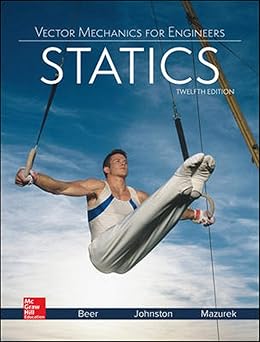Vector Mechanics for Engineers: Statics 12th Edition
by Ferdinand P. Beer, E. Russell Johnston, David Mazurek
Key Highlights
- •Authored by renowned experts Beer, Johnston, and Mazurek.
- •Features a proven, systematic vector-based approach to problem-solving.
- •Comprehensive coverage of all core Statics topics with numerous examples and problems.
Description
Struggling with your statics course? Feeling lost in forces and equilibrium? Vector Mechanics for Engineers: Statics 12th Edition by the legendary team of Beer, Johnston, and Mazurek is here to help! This isnt just another textbook; it's a lifeline for engineering students trying to conquer the fundamentals of mechanics.
Who is this book for? This book is primarily designed for undergraduate engineering students, especially those taking their first course in statics. If you're studying mechanical, civil, aerospace, or any related engineering field, this text is likely on your course list for a reason. It's also great for professionals who need a solid refresher on core statics principles.
What problem does this book solve? Let's be honest, statics can be tough. This book tackles that head-on by breaking down complex concepts into understandable parts. It addresses the common problem of visualizing forces in 3D and applying vector mathematics correctly. If you find yourself stuck on homework problems or preparing for exams, this book provide the clear explanations and step-by-step examples you need.
What will you gain from reading it? You'll develop a strong foundational understanding of equilibrium, structural analysis (trusses, frames, machines), internal forces, friction, and moments of inertia. More importantly, you'll learn the methodology – a systematic approach to problem-solving using vector analysis that engineers rely on throughout their careers. This book help you build confidence in tackling complex engineering problems.
Why is it worth reading? Beer, Johnston, and Mazurek's Vector Mechanics series is a gold standard in engineering education, trusted by universities worldwide for decades. The 12th edition continues this legacy with refined explanations, a huge number of practice problems (essential for mastery!), and clear illustrations. Its methodical approach is proven to help students succeed. Don't let statics hold you back – grab the PDF version now and start building your engineering foundation!
FAQ
Is this book good for someone completely new to physics or engineering?
It assumes some background in calculus and basic physics, as it's typically used in first or second-year university engineering programs. It explains statics from the ground up, but having prerequisite math skills is definately helpful.
Does this PDF version include answers to the homework problems?
Textbooks like this typically provide answers to selected problems (often the even or odd-numbered ones) usually at the back of the book or in an appendix within the PDF, so students can check their work.
Is the 12th edition very different from the 11th edition?
New editions usually include updated examples, new problems, clarifications based on feedback, and sometimes minor reorganization. While core concepts remain the same, your instructor might require the specific edition for homework assignments.
Can I use this book effectively for self-study outside of a formal course?
Yes, many find it clear enough for self-study, especially with its detailed examples and large number of problems. However, having access to an instructor for questions can be beneficial for tougher topics.
What makes the 'vector mechanics' approach special?
The book emphasizes using vector mathematics consistently to solve mechanics problems. This approach is powerful and systematic, helping students handle complex 2D and 3D force systems more effectively than scalar methods alone.
How quickly can I access the PDF after getting it?
Since this is a PDF format, once you acquire the file, you should be able to access it instantly on any device that supports PDF viewing.
Reader Reviews
About the Author
Ferdinand P. Beer (late) and E. Russell Johnston Jr. (late) were pioneers in engineering education, creating highly regarded mechanics textbooks known for their clarity, accuracy, and pedagogical innovation. David Mazurek joined as a co-author, continuing the legacy and updating the material for modern engineering curricula. Their works have been staples in engineering programs worldwide for generations.
